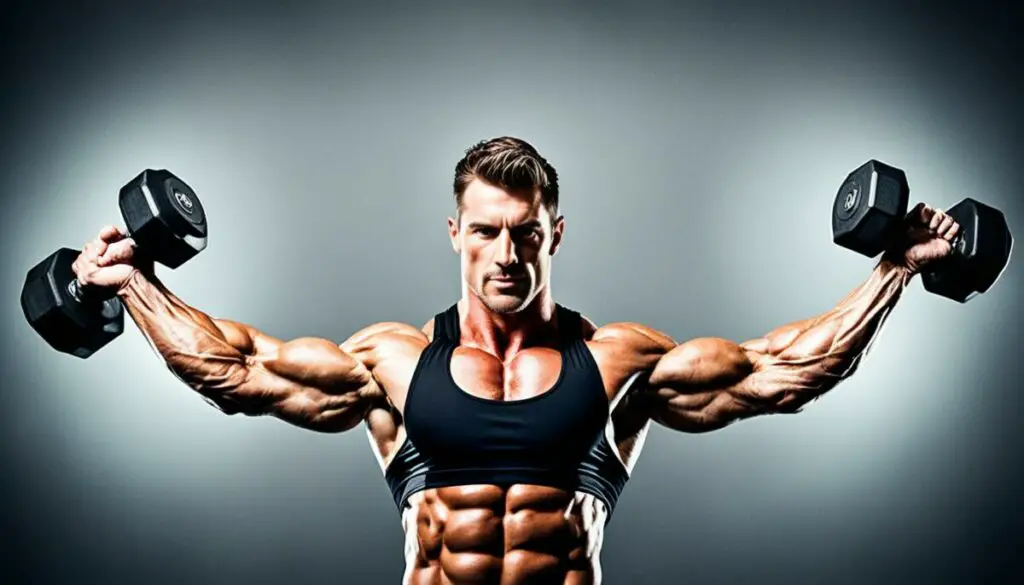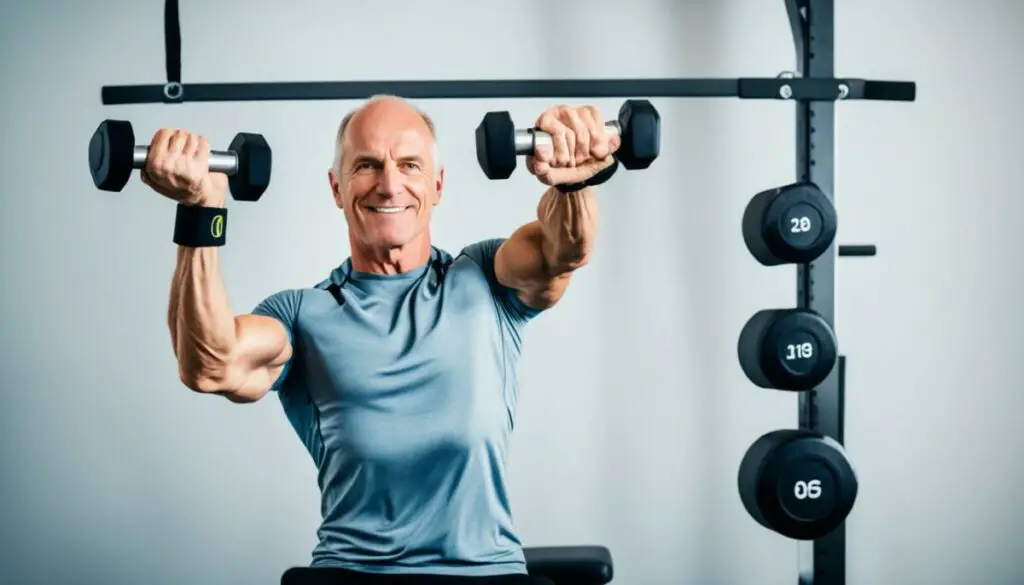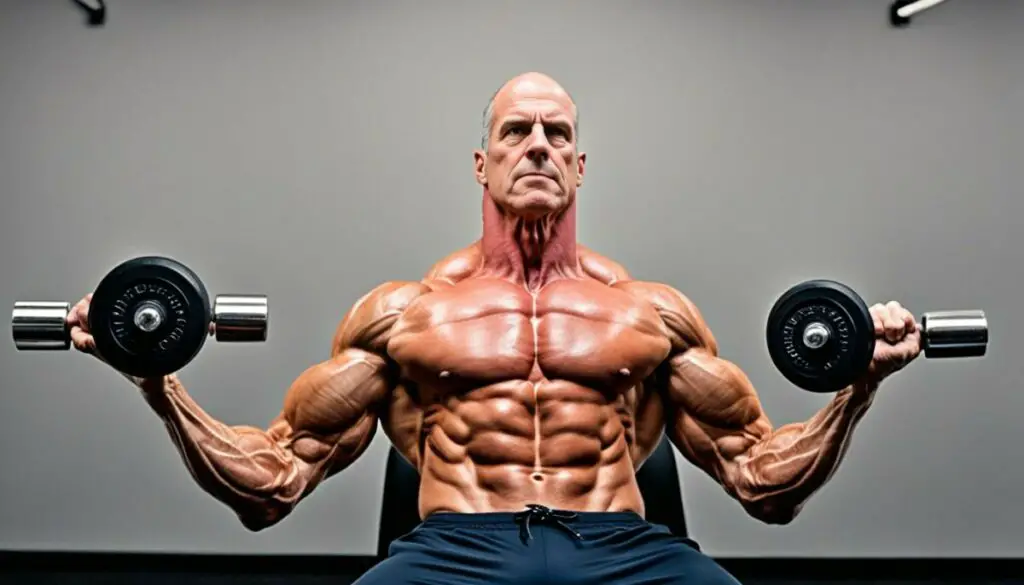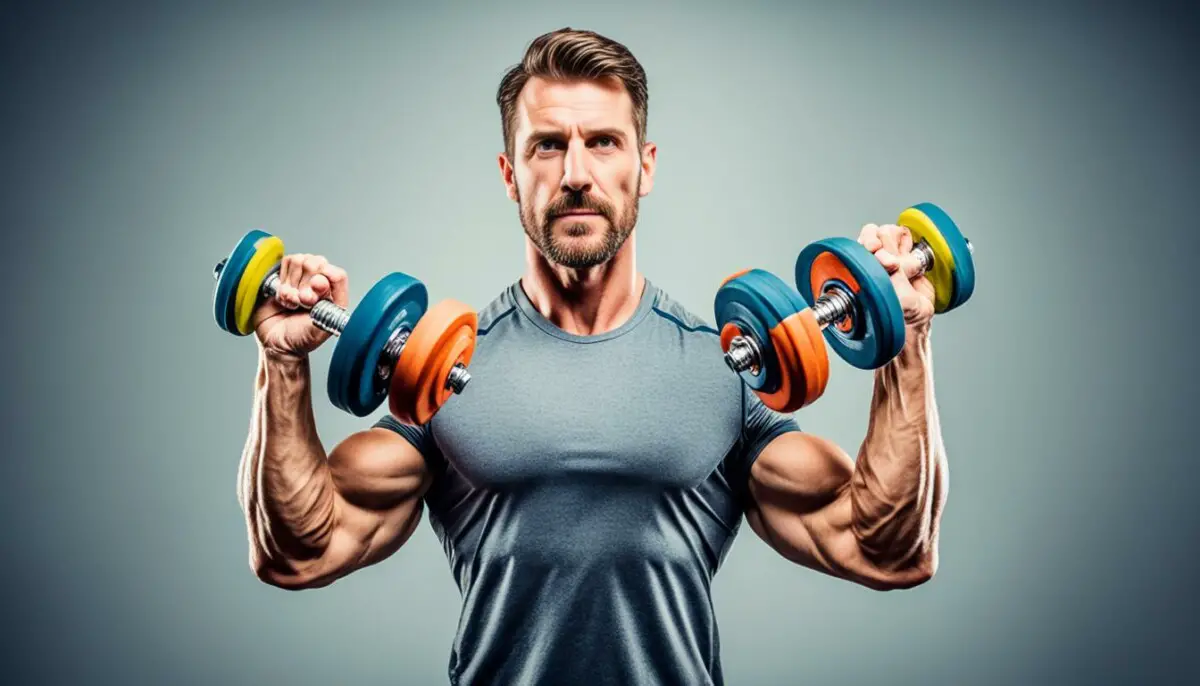Last Updated on 3 months by Francis
Welcome to our guide on mastering reverse curls with dumbbells! If you’re looking to develop bigger forearms and improve your grip strength, this exercise is for you. In this article, we will walk you through the proper form, discuss the benefits, variations, offer tips, and highlight common mistakes to avoid when performing reverse curls with dumbbells.
Reverse curls with dumbbells are a highly effective exercise that targets several key muscle groups in the arms. By incorporating this exercise into your workout routine, you can enhance your arm aesthetics, increase forearm size, and improve stability and control in your wrists and elbows.
Whether you’re a beginner or an experienced fitness enthusiast, this article will provide you with all the information you need to perform reverse curls with dumbbells correctly and achieve optimal results.
Contents
Key Takeaways:
- Reverse curls with dumbbells can help you develop bigger forearms and improve grip strength.
- Proper form is essential to maximize the benefits of reverse curls.
- There are various variations and alternatives to reverse curls with dumbbells that you can incorporate into your workouts.
- Avoid common mistakes such as lifting too heavy or using momentum.
- Adjust the weight and intensity based on your fitness level and goals.
How to Do the Reverse Curl

To perform reverse curls with dumbbells, follow these steps:
- Start by standing with your feet shoulder-width apart and holding a dumbbell in each hand.
- With a shoulder-width, double-overhand grip, raise the dumbbells by bending your elbows and curling your forearms upward.
- Squeeze at the top, contracting your biceps and forearm muscles.
- Slowly lower the weights back down to the starting position, maintaining control throughout the movement.
- Keep your upper arms against the sides of your torso to ensure proper form and alignment.
Remember to breathe throughout the exercise, exhaling as you lift the weights and inhaling as you lower them. You can also modify the grip by using an underhand or hammer grip for variation.
Sets and Reps for Reverse Curls
When it comes to reverse curls, the number of sets and reps you perform depends on your specific fitness goals. Whether you’re a beginner looking to develop your forearm strength or an experienced lifter looking to build muscle, proper form and technique are key.
For beginners, we recommend starting with 2 to 3 sets of 10 reps using a moderate weight. This will allow you to focus on mastering the proper form and technique of the exercise while gradually increasing the intensity.
If your goal is to build muscle, you’ll want to increase the weight and decrease the reps. Aim for 3 to 4 sets of 6 to 8 reps with a heavier weight. This will place more emphasis on the targeted muscles and promote muscle growth and strength development.
For those looking to improve endurance, incorporating higher rep ranges can be beneficial. Try performing 2 sets of as many reps as possible within a 30-second timeframe. This will challenge your muscles and cardiovascular system, helping to improve your stamina and endurance.
Remember, the key to achieving your goals with reverse curls is to progressively challenge your muscles over time. As you become stronger and more comfortable with the exercise, gradually increase the weight and intensity to continue making progress.
Common Mistakes in Reverse Curls

When performing reverse curls with dumbbells, it’s important to avoid common mistakes that can hinder your progress and potentially lead to injury. By understanding these mistakes and taking steps to correct them, you can ensure that you are getting the most out of your reverse curl workouts.
Lifting Too Heavily
Lifting too heavy a weight is a common mistake in reverse curls. This can put unnecessary strain on your wrists and elbows, increasing the risk of discomfort or injury. It’s important to choose a weight that allows you to maintain proper form throughout the exercise. Start with a lighter weight and gradually increase the load as you build strength and proficiency.
Using Momentum and Swinging
Using momentum and swinging your body to lift the weight is another mistake to avoid. This not only reduces the effectiveness of the exercise but also places strain on other areas of your body, such as your lower back. Focus on using controlled and deliberate movements, engaging the targeted muscles without relying on momentum.
Not Accommodating Your Grip
Not accommodating your grip can also hinder your performance in reverse curls. If you find that you are struggling to maintain your grip on the dumbbells, consider using alternative equipment such as Fat Gripz or towels to increase grip strength. Additionally, using a challenging weight that requires you to engage your grip can enhance the benefits of the exercise.
Avoiding these common mistakes will help you perform reverse curls with proper form, maximizing the benefits of this exercise. By lifting an appropriate weight, avoiding momentum, and accommodating your grip, you can improve your forearm strength and enhance your overall performance.
Variations of Reverse Curls

Looking to spice up your reverse curls with dumbbells? Incorporating variations into your workouts can help you target different aspects of your forearm and upper arm muscles. Here are a few ideas to add some excitement to your routine:
1. Fat Gripz or Towels
For an added challenge, try using Fat Gripz or towels during reverse curls. These grip enhancers increase the diameter of the dumbbell handle, forcing your forearms to work harder to maintain a secure grip. This not only strengthens your grip but also engages your forearm muscles more intensely.
2. Cable Reverse Curls
Switching to cable reverse curls can provide a unique stimulus to your upper arms and forearms. Using a cable machine with an attachment such as a straight bar or rope, stand facing the machine and hold the handle with an overhand grip. Curl your forearms upward while keeping your upper arms stationary. The constant tension provided by the cable throughout the movement emphasizes the muscles in your upper arms and forearms.
3. Dumbbell Reverse Curls
If you prefer to work each arm independently, try incorporating dumbbell reverse curls into your routine. Stand with your feet shoulder-width apart and hold a dumbbell in each hand. With your palms facing downward, curl one dumbbell at a time, focusing on the contraction of your forearm muscles. This unilateral exercise helps improve muscle imbalances and allows you to give each arm the attention it deserves.
Whether you choose to challenge your grip with Fat Gripz, emphasize your upper arms with cable reverse curls, or focus on each arm independently with dumbbell reverse curls, these variations can take your reverse curl game to the next level. Experiment with different techniques to keep your workouts fresh and maximize the benefits of this effective exercise.
Alternatives to Reverse Curls

If reverse curls with dumbbells don’t suit your preferences or if you experience discomfort, there are alternative exercises that target similar muscle groups. Consider incorporating the following exercises into your workout routine:
-
Hammer Curls
Hammer curls are a great alternative to reverse curls as they also target the brachialis and brachioradialis muscles in the forearms. Hold a dumbbell in each hand with a neutral grip (palms facing each other), and then curl the weights up towards your shoulders while keeping your elbows close to your sides.
-
Zottman Curls
Zottman curls are a compound exercise that target not only the biceps but also the brachialis and brachioradialis muscles. Start with a dumbbell in each hand and curl them up with your palms facing up. At the top of the movement, rotate your wrists so that your palms face down, and then slowly lower the weights while keeping your palms facing down.
-
Wide-Grip Barbell Rows
Wide-grip barbell rows primarily target the upper back muscles, but they also engage the forearms. Grab a barbell with a wider-than-shoulder-width grip and pull the weight towards your lower chest, squeezing your shoulder blades together. Focus on maintaining proper form and feeling the activation in your forearms.
-
Pull-Ups
Pull-ups are a challenging bodyweight exercise that engage multiple muscle groups, including the forearms. Grab a pull-up bar with an overhand grip, slightly wider than shoulder-width apart. Hang from the bar and then pull yourself up until your chin is above the bar. Lower yourself back down with control. If pull-ups are too difficult, you can use an assisted pull-up machine or resistance bands to help you.
These exercises provide effective alternatives to reverse curls with dumbbells, allowing you to continue targeting the same muscle groups while adding variety to your workouts. Experiment with different exercises and find what works best for you. Remember to maintain proper form and gradually increase the difficulty as you progress.
Muscles Targeted in Reverse Curls

When performing reverse curls with dumbbells, you engage several key muscle groups in the arms and forearms. Here are the primary muscles targeted:
- Biceps Brachii: The biceps brachii is the main muscle responsible for flexing the elbow joint. It is located on the front of the upper arm and plays a significant role in the reverse curl movement.
- Brachialis: The brachialis is a deep muscle located underneath the biceps brachii. It assists in elbow flexion and contributes to the overall strength and size of the arm.
- Brachioradialis: The brachioradialis is a forearm muscle that runs from the upper arm to the wrist. It helps with both elbow flexion and forearm pronation, making it an essential muscle in reverse curls.
- Extensor Carpi Radialis: This muscle is located on the back of the forearm and assists in extending and abducting the wrist. It plays a vital role in wrist stability during the reverse curl exercise.
- Extensor Digitorum: The extensor digitorum is a forearm muscle responsible for extending the fingers and wrist. It is actively engaged during reverse curls, helping to maintain grip strength and stability.
- Extensor Carpi Ulnaris: Located on the ulnar (pinky finger) side of the forearm, the extensor carpi ulnaris is involved in extending and adducting the wrist. It adds to overall forearm stability during reverse curls.
By targeting these muscle groups, reverse curls with dumbbells effectively build strength, size, and stability in the arms and forearms, leading to improved performance in various activities that require grip strength, such as weightlifting, rock climbing, and racquet sports.
Quote:
“Reverse curls target the key muscles involved in elbow flexion and forearm stability, making them an essential exercise for developing stronger and more defined arms.”
Benefits of Reverse Curls

Reverse curls with dumbbells offer a range of benefits that can enhance your arm workouts and overall fitness. Incorporating this exercise into your routine can lead to:
- Increased forearm size: Reverse curls specifically target the muscles in your forearms, helping to increase their size and strength.
- Improved grip strength: By working the muscles responsible for gripping, reverse curls help to strengthen your grip, which can be beneficial for various activities such as weightlifting, rock climbing, and racquet sports.
- Balanced muscle development in the arms: Reverse curls target the brachialis, brachioradialis, and biceps brachii muscles, promoting overall arm muscle development and symmetry.
- Enhanced stability and control in the wrists and elbows: The controlled movement of reverse curls engages the stabilizer muscles in the wrists and elbows, improving stability and control in these joints.
- Decreased risk of injury: Developing stronger forearms and grip strength through reverse curls can reduce the risk of injury during exercises that require a strong grip.
By adding reverse curls with dumbbells to your workout routine, you can achieve well-rounded arm development, improve grip strength, and enhance your overall athletic performance.
Who Should Do Reverse Curls
Reverse curls with dumbbells are a versatile exercise suitable for individuals of all fitness levels who are looking to develop their forearms, improve grip strength, and enhance the overall aesthetics of their arms. However, certain groups of people can benefit even more from incorporating reverse curls into their workout routine.
- Athletes: Reverse curls are particularly beneficial for athletes involved in activities that require a strong grip, such as weightlifting, rock climbing, and racquet sports. By strengthening the forearms and improving grip strength, athletes can enhance their performance in these sports and reduce the risk of injuries related to grip fatigue.
- Bodybuilders: Bodybuilders aiming to achieve a well-rounded, symmetrical physique can benefit from including reverse curls in their arm workouts. This exercise targets the often overlooked brachioradialis muscle, contributing to overall arm development and balance.
- Individuals with Weak Grip: If you struggle with grip strength, whether due to daily activities or previous injuries, reverse curls can help you improve your grip and enhance overall hand and forearm strength. Stronger grip strength can have a positive impact on various day-to-day activities, such as carrying heavy objects or opening jars.
- Individuals Seeking Aesthetic Arm Development: If you desire more defined forearms and overall arm aesthetics, reverse curls can help you achieve your goals. By targeting the brachioradialis muscle and other forearm muscles, reverse curls contribute to a well-rounded and impressive arm appearance.
Regardless of your fitness level or specific goals, incorporating reverse curls into your workout routine can yield significant benefits. Remember to start with an appropriate weight, focus on proper form, and gradually increase the intensity as your strength and proficiency improve.
Tips for Performing Reverse Curls
Mastering the proper technique for reverse curls with dumbbells is crucial for maximizing your results. Here are some tips to help you perform reverse curls effectively:
- Start with lighter weights: If you’re new to reverse curls, begin with a weight that allows you to maintain proper form. Focus on mastering the movement before gradually increasing the weight.
- Maintain control: Throughout the exercise, avoid excessive swinging or using momentum to lift the weights. Slowly lift the dumbbells using your forearm muscles, focusing on the contraction at the top of the movement.
- Engage your core: To enhance stability and prevent excessive body movement, engage your core muscles throughout the exercise. This will help maintain proper posture and control.
- Listen to your body: Pay attention to how your body responds to the exercise. If you experience any discomfort or pain, adjust the weight and intensity accordingly. It’s important to work within your limits and progress gradually.
By following these tips, you’ll be able to perform reverse curls with dumbbells safely and effectively, ultimately achieving the desired results for your forearm development and grip strength.
Testimonials:
“I used to struggle with the proper technique for reverse curls, but after following these tips, I’ve seen significant improvements in my forearm strength and size. Highly recommend!” – Mark
“Incorporating core engagement and starting with lighter weights made a huge difference in my reverse curl performance. Thanks for the helpful tips!” – Emily
| Tips | Benefits |
|---|---|
| Start with lighter weights | – Allows for proper form – Reduces the risk of injury – Builds a strong foundation for progression |
| Maintain control | – Targets the intended muscles effectively – Enhances mind-muscle connection – Minimizes reliance on momentum |
| Engage your core | – Improves stability and balance – Supports proper posture – Enhances overall performance |
| Listen to your body | – Promotes injury prevention – Allows for individualized progression – Creates a customized fitness experience |
Conclusion
Reverse curls with dumbbells are a highly effective exercise for building bigger forearms and improving grip strength. By following proper form and incorporating variations and alternatives, you can maximize your results and enjoy the benefits of this exercise. Remember to adjust the weight and intensity based on your fitness level and goals.
One of the key advantages of reverse curls is their ability to target the biceps brachii, brachialis, and brachioradialis muscles, resulting in balanced arm development. Additionally, reverse curls engage the extensor muscles in the forearms, enhancing grip strength and forearm stability.
When performing reverse curls, it’s essential to avoid common mistakes such as lifting too heavily, using momentum, or neglecting grip accommodation. By maintaining control throughout the movement and listening to your body, you can decrease the risk of injury and optimize your performance.
Incorporating reverse curls into your arm workouts will not only help you develop bigger forearms but also enhance your overall arm aesthetics. Whether you’re an athlete looking to improve grip strength or an exercise enthusiast seeking balanced arm development, reverse curls with dumbbells are an excellent addition to your fitness routine.
FAQ
How do I perform reverse curls with dumbbells?
Begin by standing with feet shoulder-width apart, holding a dumbbell in each hand. With a shoulder-width, double-overhand grip, raise the dumbbells by bending your elbows and curling your forearms upward. Squeeze at the top and slowly lower the weights back down to the starting position, keeping your upper arms against the sides of your torso.
What are the recommended sets and reps for reverse curls?
For beginners, 2 to 3 sets of 10 reps with a moderate weight is recommended. To build muscle, aim for 3 to 4 sets of 6 to 8 reps with a heavier weight. For endurance, try 2 sets of as many reps as possible in 30 seconds. Adjust the weight accordingly to challenge your muscles and progress over time.
What are common mistakes to avoid in reverse curls?
Common mistakes include lifting too heavily, using momentum and swinging the body, and not accommodating the grip by using a challenging weight or alternative equipment.
What are some variations of reverse curls with dumbbells?
Some variations include using Fat Gripz or towels to increase grip strength, performing cable reverse curls to emphasize upper arms and forearms, and opting for dumbbell reverse curls to work each arm independently.
What are some alternatives to reverse curls with dumbbells?
Alternatives include hammer curls, Zottman curls, wide-grip barbell rows, and pull-ups to target similar muscle groups.
Which muscle groups are targeted in reverse curls?
Reverse curls primarily target the biceps brachii, brachialis, and brachioradialis muscles. They also engage the extensor carpi radialis, extensor digitorum, and extensor carpi ulnaris muscles for grip strength and forearm stability.
What are the benefits of reverse curls with dumbbells?
The benefits include increased forearm size and grip strength, balanced muscle development in the arms, improved stability and control in the wrists and elbows, and a decreased risk of injury during exercises requiring grip strength.
Who should do reverse curls with dumbbells?
Reverse curls are suitable for individuals of all fitness levels who want to develop their forearms, improve grip strength, and enhance overall arm aesthetics. They are particularly beneficial for athletes involved in activities that require grip, such as weightlifting, rock climbing, and racquet sports.
What are some tips for performing reverse curls with dumbbells?
Start with lighter weights and focus on proper form before progressing to heavier weights. Maintain control throughout the movement and avoid excessive swinging or using momentum. Engage your core and keep your body stable. Listen to your body and adjust the weight and intensity as needed.








